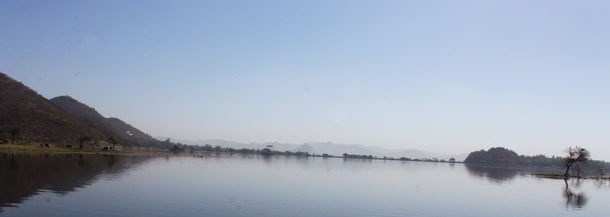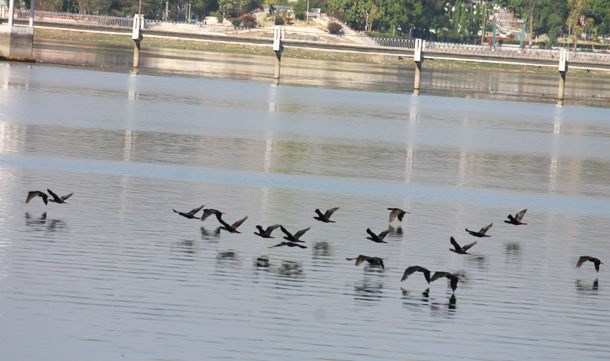Faunal History of Fatehsagar Lake, Udaipur
Fatehsagar is the heart of Udaipur. Not only the resident and tourist humans flock it, but also resident and tourist birds. It is the home of many aquatic and semi-aquatic animals as well. Fatehsagar Lake was built during monarchy. Its area is 20.7 sq km. and attracts a large number of birds, both nomadic as well as migratory. The water spread is 427 M cft. It has four islands.
By Raza H. Tehsin
 Fatehsagar is the heart of Udaipur. Not only the resident and tourist humans flock it, but also resident and tourist birds. It is the home of many aquatic and semi-aquatic animals as well.
Fatehsagar is the heart of Udaipur. Not only the resident and tourist humans flock it, but also resident and tourist birds. It is the home of many aquatic and semi-aquatic animals as well.
Fatehsagar Lake was built during monarchy. Its area is 20.7 sq km. and attracts a large number of birds, both nomadic as well as migratory. The water spread is 427 M cft. It has four islands.
One is converted into a garden called Nehru Park. On the smaller one, a Solar Observatory has been erected. The third, a rocky outcrop, is converted into a fountain and the fourth one is just near the northwestern shore.
The catchment of this lake is very small. Most of its water comes from Pichola Lake through a canal. Near Loira village there is a small dam on Berach River and the water of that river is diverted to Fatehsagar through a canal popularly known as Madar-ki-Nahar.
The main source of water for Pichola is Sisarma River and from Pichola it is diverted to yet another small lake called Swaroop Sagar and from there into Fatehsagar. The sitting problem of this lake is not so acute.
Before independence, the water from this lake was hardly used for any purpose and it remained more or less full throughout the year. The water was so clean that in those days most of the British officers used it for drinking purpose. All the three islands were full of vegetation and hundreds of aquatic birds and waders used it for nesting. Apart from this, at the periphery of the lake, there were numerous trees used by birds as heronries.
Faunal History
The bigger island was an ideal habitat for pythons as these reptiles lead almost semi-aquatic life. There was no scarcity of food as there were hundreds of birds’ nests and roosting places.
The huge pythons on this island were often encountered with those days. Their diet of birds and eggs was occasionally supplemented by otters. There were good number of otters in the lake and this island was their favourite basking and littering place.
There were strict restrictions on fishing and therefore the lake was choked with several types of fish. Apart from fish eating birds, the population of crocodiles was also fairly good.
Another mammal, which mostly depends upon fish, i.e. otter, was also in good numbers. As the lake remained more or less full throughout the year, reeds and other aquatic vegetation were in plenty in the shallow region, which was an ideal feeding ground for birds. Several types of migratory birds wintered in this lake. The human interference was restricted to bathing and washing of clothes and that too in a limited area. The population was practically confined inside the walled city and there were two more lakes nearer to the city. Fatehsagar was a most balanced and perfect wetland.
Exploitation
After independence, the trees looming over the water edge were chopped off thereby reducing the heronries.
Then started a chain reaction Government allotted contract for killing of crocodiles in early fifties. These harmless reptiles were mercilessly killed by contractors for their skin and within two years almost all of them were accounted for. Government introduced fish contractors and it resulted in considerable depletion of fish fauna.
The fisheries department periodically stocks the lake with fingerlings of exotic, commercially viable fish of three or four types only; the other fish, especially catfish, are now on the threshold of extinction in the lake.
Mahasher (the water lion) is a fish very good for angling. Because it grows slowly it was not restocked and is now extinct from Fatehsagar. Carnivore fish like Sanval, Singara, Lanchi, very important for the lake’s ecosystem, are not restocked. Weed fish are also not restocked as they don’t increase in size. Bigger commercially viable fish Katla gains two kilograms in one year.
The fingerlings that are introduced in the lake are first bred and increased in size in the nurseries. Cormorants, storks, snake birds which live on weed fish are reducing, as they can’t catch big fish. Several once permanent marshy places with reeds and other types of aquatic fauna and flora have vanished.

Habitat Destruction
Residential houses are coming up around this lake and some people have even claimed the submerged area. The discharge from these colonies is directly polluting the water.
One of the islands, an ideal basking and egg-laying place for crocodiles. is no more an island. All the trees are chopped off and now it is barren. During rainy season it remains as an island for about two months only.
The bigger island is converted into a park called Nehru Park. All of its natural vegetation, its heronries, its pythons and otters have disappeared. Now it is a recreation place for visitors, especially tourists. From the shore people go by mechanized boats to this island. The oil spillage from these boats is affecting the aquatic fauna and flora and the smoke is polluting the air.
Several khomchawalas outside the lake and a restaurant inside the lake throw garbage into it. The greatest amount of garbage is thrown in the lake during the Hariyali Amawas fair. The garbage is in the form of metallic caps of cold drink bottles, ice cream cups, paper or leaf plates, plastic bags etc. It has been estimated in 1986 that the garbage thrown into the lake is about five tonnes per annum (in which the Hariyali Amawas fair garbage is not included) and its quantity is increasing day by day. Due to this activity, the bottom might gradually come up at the points where the garbage is thrown.
Need for Conservation
Due to lack of aquatic vegetation and constant disturbances in and around the lake by automobiles and boats, the lake is becoming less hospitable for a variety of migratory birds. In all 66 birds belonging to 15 families have been observed in the lake. But now Grey-legged Goose, Bareheaded Goose, Demoiselle Crane, which were the most common sight in winter, are no more seen and Brahminy Ducks and Teals have become a rare sight.
Due to overexploitation of water, Fatehsagar started breathing heavily for survival. During the last few decades it came many a times on the brink of drying. But it did not happen. The old lake continued its doleful, lone struggle.
Then came the year of 2003 when its struggle ended. In its history, Fatehsagar dried entirely for the first time. For the fish contractors the drying of the lake provided unmatched opportunity to gather all the commercially viable or non-viable fish.
Pelicans came in large flocks visiting the lake in 2002, as the waters were very shallow in winter. But even those water holes dried in the scorching heat of summer.
At least in one-third of the lake, which consists of both shallow and deep waters, should be left untouched from fishing, boating or any other disturbance. The damage done to this wetland is irreversible but still we can rectify some of our gross mistakes and for this we have to take some drastic steps to save this wetland. Otherwise in due course of time this lake will be converted into a semi-sewerage pond.
First Published in the book Wetland Conservation in 1989
To join us on Facebook Click Here and Subscribe to UdaipurTimes Broadcast channels on GoogleNews | Telegram | Signal


